
Feli Nandi, Dorcas Moyo to perform at Manicaland Motoring Club’s first solo family show
July 27, 2024
Nabbed pangolin poachers trial date set
August 9, 2024Modern high-rise glass buildings boom in Mutare
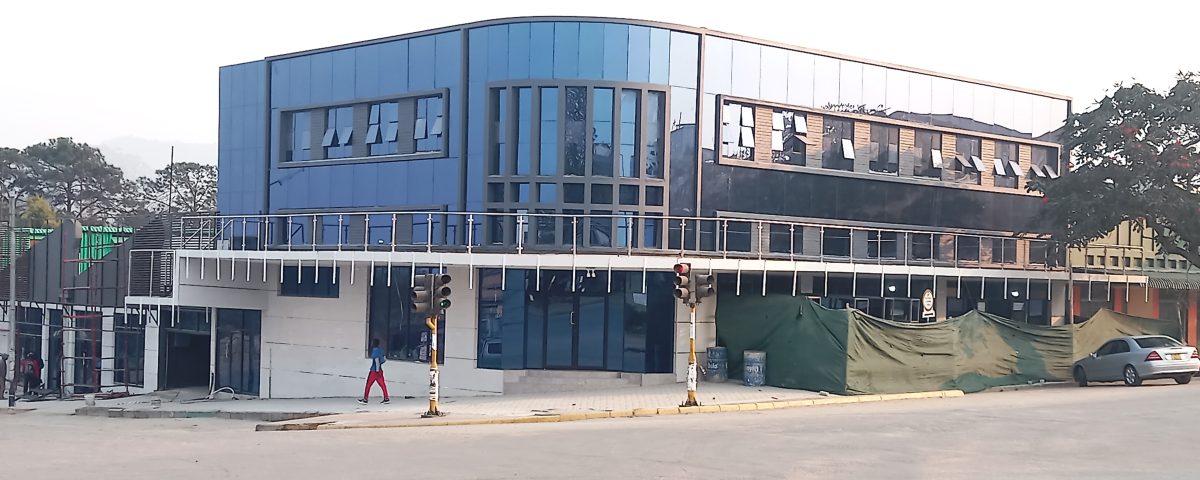
One of the modern glass buildings under renovation in Mutare owned by a company allegedly owned by the Mukumba brothers.
Ngoni Dapira
AFTER almost two decades of little noteworthy facelift in Mutare’s central business district (CBD) there is now a major boom in the construction of modern high rise façade glass buildings in the Second Republic, Easterntimeszim has learnt.
A snap survey this week by Easterntimeszim in the eastern border city of Mutare, which is the capital city of Manicaland Province, shows that in the past eight years there has been massive construction of contemporary high rise builds in the CBD, whilst several commercial properties are also being face-lifted into new appealing buildings.
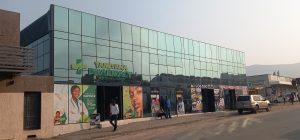
One of the new glass building along first street that allegedly belongs to the Minister of Youth Empowerment, Development and Vocational Training Hon Tino Machakaire recently opened in Mutare.
Façade glass, also known as curtain wall glass, is a type of glass used in the construction of buildings for interior and exterior. According to experts using glass in architecture instead of traditional concrete, facades allows maximum light to penetrate into spaces, reducing thousands of dollars in energy consumption every year.
Façade glass can also be used to create a more aesthetically pleasing building design. The use of large panels of glass in the façade can give a building a modern and sleek appearance, making it stand out in a crowded urban landscape like the CBD.
In terms of infrastructure development history after independence in 1980, the first commercial double storey building to be constructed in the CBD by an individual black businessman was in Mutare by Joseph Sanhanga, the Sanhanga Centre. It was historically important then to the extent that it was commissioned in 1992 by the late former President Robert Mugabe who credited Sanhanga’s singular achievement as foresight that radiated the potential benefits of black empowerment post-independence.

The Fidelity Life Centre building.
On the other hand, before the Sanhanga Centre, in terms of history of post- independence buildings in Mutare, the grandiose attraction was the eight storey Fidelity Life Centre building which was commissioned in 1991, owned by ZIMRE Properties. Up-to-date it remains the highest building in the city and the archetype of post-independence buildings celebrated in Mutare.
Mutare is the fourth largest city in Zimbabwe after Harare, Bulawayo and Gweru respectively. However in terms of modernization of commercial buildings and infrastructure development growth, especially in its CBD, there had been insignificant development for a long time. It is a cosmopolitan city because of its vast natural resources where a lot of people come to try and strike their fortune. The city is surrounded by mountains and breathtaking mountain range views so it was coined the Switzerland of Africa because of its similarity to Switzerland in terms of landscape features.
Given that Manicaland Province is the only province in the country with all the five ecological regions, which means the province is grossly rich and endowed with vast minerals and natural resources, a lot of hope was pinned on seeing robust infrastructure development in the province, particularly in Mutare.
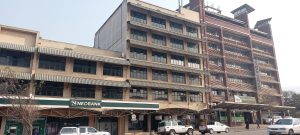
The ZIMRE building (extreme right) along Main Street commissioned in 2001 and the Msasa-Windsor House.
Between 1992 and 2005 there were other commercial buildings constructed in the CBD, but not at the anticipated growth rate and the buildings were mostly built by quasi government institutions, the likes of ZIMRE building along Main Street commissioned in 2001 and Msasa-Windsor House adjacent to it which was commissioned in 2005.
However, in 2006, following the discovery of diamonds in Chiadzwa, which led to the Chiadzwa diamond rush in 2007, a game changer emerged and local economists perceived that Mutare would be turned into a robust diamond city with modern iconic buildings and flourishing industry. Nevertheless, the free for all diamond rush was ended in 2008 when Government launched Operation Hakudzokwi (No Return), which ran up to January 2009, arresting all suspected diamond dealers and seizing part of their assets as ill-gotten wealth, using lifestyle audit as the basis of its investigations. Sadly, the diamond city vision remains a pipedream as there was never significant growth in the real estate sector, especially construction of commercial buildings, with the exception of residential houses, where many individuals benefited directly or indirectly from proceeds of the diamond boom back then.
In 2017, during a Zimbabwe National Chamber of Commerce (ZNCC) breakfast meeting with Manicaland businesspeople in Mutare, whilst still the Finance and Economic Development Minister, Patrick Chinamasa admitted that Government had failed to develop Manicaland through its diamonds and vast mineral resources. He cited how back in 2008 up to 2012, Mutare had become very active and economically robust because of spillover effects of money from the ‘illicit’ trade of diamonds from Chiadzwa.
This was after local businesspeople had quizzed Minister Chinamasa , who also hails from Manicaland province, over concerns that since independence Mutare had little to show off in terms of infrastructure development and economic growth, regardless of having vast natural resources.
Between 2005 and 2017 some notable commercial buildings were constructed by individuals, but again not at the anticipated growth rate. Towers Properties, built by the late Dr Oliver Mapunga in 2012 was the first modern double storey building with a façade glass exterior. This was another notable development in the CBD by an individual businessman though by then many entrepreneurs were now investing in commercial properties in the industrial areas.
However, under the new dispensation government in the second Republic, a phrase that refers to the government of President Emmerson Mnangagwa, ever since he took over the reins from the late former President Mugabe in a ‘coup’ in 2017, and went on to be elected in the 2018 and re-elected in last years harmonized elections, there is a striking investment towards the development of commercial properties in the CBD in Mutare.
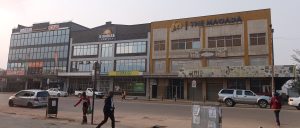
The block of high rise buildings down town along Main Street constructed under the new dispensation government by individual entrepreneurs.
Since 2018, in down town Mutare there are many high rise buildings built by individual entreprenuers, the most illustrious being the likes of Magada building, Sunrise Complex and Krown Plaza Complex, which are along Main Street. Uptown there is the Chitowa Building and the Village Mall to mention a few, whilst several properties have been renovated to meet the current demand of small business shops or units.
It is however the recent boom since 2021 that is really giving a new makeover to Mutare which will surprise those that have not been in the city in the past 20 years. The high-quality glass buildings under construction and the renovations of several old Indian shops turned into modern compartmental shops is really overwhelming.
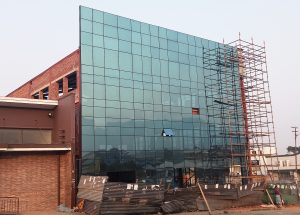
Another glass building still under construction along Second Street that allegedly belongs to the Minister of Youth Empowerment, Development and Vocational Training Hon Tino Machakaire
The most striking are facade glass buildings allegedly built by the Minister of Youth Empowerment, Development and Vocational Training Hon Tino Machakaire and the Mukumba brothers who seem to have developed a keen interest in commercial properties and the hospitality sectors, expanding from their trademark transport businesses.
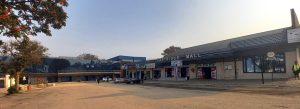
The other building built by a company allegedly owned by the Mukumba brothers.
City of Mutare acting director spatial planning Tonderai Sango confirmed that Mutare had over the years lost its sparkle, but the local authority embarked on a beautification programme in 2020 to restore its former glory. He said there has been a notable increase in applications for construction in the commercial sector.
“I might not have the correct answer on why it is happening since 2018, but I can confirm that we are having many applications for modern buildings coming up in the city and we are really excited by this development as we move towards the smart city concept,” said Sango.

Tonderai Sango
Sango said through the ‘Call to Action’ blueprint launched last year by President Mnangagwa for local authorizes as an intervention to modernize the operations of local authorities towards vision 2030, they have since issued a directive to property owners to rehabilitate and repaint their buildings and to embrace smart cities. They are encouraging the construction of high rise buildings. “It’s a process of engagement and we are happy with the response so far,” said the City of Mutare town planner.
Economist Thomas Masese explained the infrastructure boom as a sign of sound policies and confidence by diasporans who want to invest in properties.

Thomas Masese
“Through the President’s (Mnangagwa) ‘Call for Action Blue print for Local Authorities’, government instructed all local authorities to give notice to all property owners in towns to renew their buildings or else they would be closed. In addition a number of diasporans and young entrepreneurs are beginning to see that investment in property is the best source of passive income,” said Masese.
He said the new buildings and those being renovated is a response to the market response adding that the government’s infrastructure development drive is putting the economy in a modernisation mode. “You can even see with the modern homes being built in rural areas. Demand for mall type rental spaces by MSMEs (Micro, Small and Medium Enterprises) has also seen entrepreneurs renewing their structures to suit the new type of customers in our SME’s (Small to Medium Enterprises) driven economy. So the economy is moving with the times,” he said.


